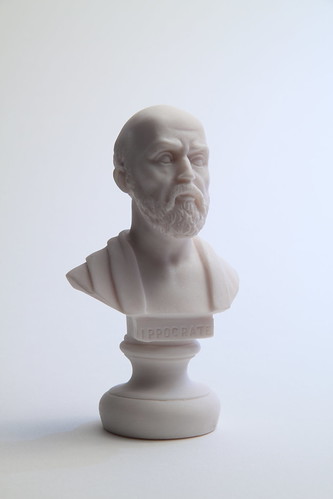Hippocrates: Uncovering the Real Cause and Cure of Disease
 Hippocrates: The Father of Western Medicine, had a great understooding of the principle of the Tao and used this principle to heal people with it. He referred to it as vis medicatrix naturae—the healing power of nature which cures us from within. Hippocrates described disease as a combo of Pathos, suffering, and Ponos, toil. Suffering represents the state of disharmony within the ailing person, and toil is the body’s response to this suffering as it tries to find stasis and harmony again. Or in other words, each human body wants and gravitates towards health and balance. The Tao or Being—simply existing—is our natural state. Suffering occurs when we are not rooted in Being, the timeless eternal reality. Nature can cure and heal us from within, but it is necessary to harmonize and understand nature. Medications and surgery can aid in a cure, but they must be used wisely and understood to be aiding nature. This idea is rarely used today, because most people depend strictly on medication and technology to find healing, instead of finding a balance with nature.
Hippocrates: The Father of Western Medicine, had a great understooding of the principle of the Tao and used this principle to heal people with it. He referred to it as vis medicatrix naturae—the healing power of nature which cures us from within. Hippocrates described disease as a combo of Pathos, suffering, and Ponos, toil. Suffering represents the state of disharmony within the ailing person, and toil is the body’s response to this suffering as it tries to find stasis and harmony again. Or in other words, each human body wants and gravitates towards health and balance. The Tao or Being—simply existing—is our natural state. Suffering occurs when we are not rooted in Being, the timeless eternal reality. Nature can cure and heal us from within, but it is necessary to harmonize and understand nature. Medications and surgery can aid in a cure, but they must be used wisely and understood to be aiding nature. This idea is rarely used today, because most people depend strictly on medication and technology to find healing, instead of finding a balance with nature.
Resolving To Uncover the Real Cause of Disease
Thomas Sydenham, who was viewed as the English Hippocrates of the seventeenth century, stated that: “Disease is nothing else but an attempt on the part of the body to rid itself of morbific (diseased, toxic) matter.”
Twentieth century American physician, J.H. Tilden, MD spent years wandering in the jungles of medical diagnosis, and eventually became frustrated. He declared, “I resolved either to quit the profession or to find the cause of disease.” Dr. Tilden saw that that in any normal life cycle, cellular metabolism occurs, and which in turn causes waste. This concept is similar to cars that produce exhaust… the cells within our body naturally produce small amounts of waste. When the body is unable to eliminate the waste that is produced (either through cellular metabolism or the additional waste accumlated thru contact with environmental toxins), it slowly becomes diseased as a result of the toxicity. Dr. Tilden was able to identify the cause why the body is unable to eliminate all waste, which he called habits of enervation. And he came to the same conclusion as the Yellow Emperor’s Classic on Internal Medicine, likely without seeing or knowing of the previous findings. The discovery of the conclusion is that disease is caused by habits which stimulate the body excessively. A few examples that were given by Dr. Tilden are staying up too late, excessive smoking and drinking, over-working, and eating too much sugar. Also, toxic emotions such as greed or fear contribute to this overstimulation within the body.
This new disease paradigm has a common thread: Our behaviors are the cause of disease. If our habits and behaviors can significantly contribute or even cause disease to occur, then how can the diseased state be seperated from the patient who is suffering from the disease, as if the patient has nothing at all to do with its creation? Dr. Tilden looks at this conundrum and he boldly states:
There is no hope that medical science will ever be a science; for the whole structure is built around the idea that there is an object disease—that can be cured when the right drug—remedy, cure—is found.
Usually, a cure for a disease should lie in seeing the symbiotic relationship between the individual, the disease, and the environment, which includes the earth under his feet, his food, his home, his family, and his society.
Photo Credit: a.drian from







